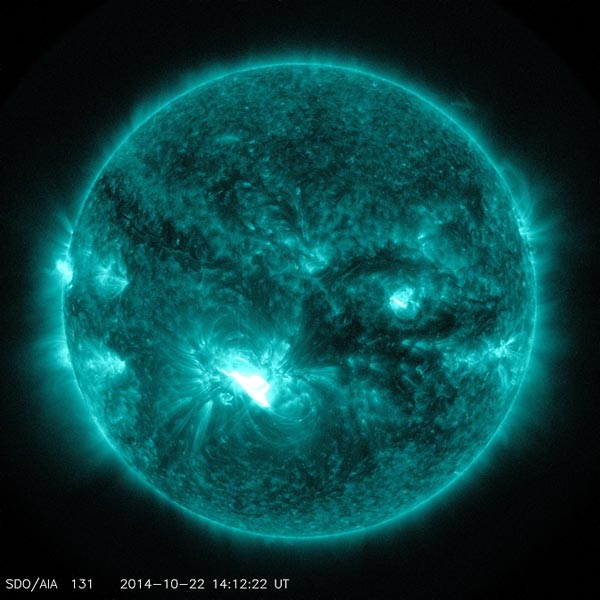Third Substantial Solar Flare in 2 Days

An X1.6 class flare erupted from the lower half of the sun, as seen in the bright flash of light in this image from NASA's SDO. This image shows extreme ultraviolet light with a wavelength of 131 Angstroms, which highlights the intense heat of a solar flare and which is typically colorized in teal. Image Credit: NASA/SDO
NASA’s Solar Dynamics Observatory captured images of the event, which occurred in the lower half of the sun. This flare is classified as an X1.6 class flare. X-class flares denote the most extreme flares. This is the third substantial flare from the same region of the sun since Oct. 19.
To see how this event may affect Earth, please visit NOAA's Space Weather Prediction Center at http://spaceweather.gov, the U.S. government's official source for space weather forecasts, alerts, watches and warnings.
Second Substantial Flare in Two Days – First Update: Oct. 22, 2014, 9:45 a.m. EDT
The sun emitted a mid-level solar flare, peaking at 9:59 p.m. EDT on Oct. 21, 2014. NASA's Solar Dynamics Observatory, which is always observing the sun, captured an image of the event. The same active region previously emitted an X1.1 solar flare on Oct. 19. Solar flares are powerful bursts of radiation. Harmful radiation from a flare cannot pass through Earth's atmosphere to physically affect humans on the ground, however — when intense enough — they can disturb the atmosphere in the layer where GPS and communications signals travel.
To see how this event may affect Earth, please visit NOAA's Space Weather Prediction Center at http://spaceweather.gov, the U.S. government's official source for space weather forecasts, alerts, watches and warnings.
This flare is classified as an M 8.7-class flare.
M-class denotes flares that are a tenth as strong as X-class flares, which are the most intense flares. The number provides more information about its strength. An M2 is twice as intense as an M1, an M3 is three times as intense, etc.
Updates will be provided as needed.
What is a solar flare?
For answers to this and other space weather questions, please visit the Spaceweather Frequently Asked Questions page.
Related Links
- › Related multimedia from NASA Goddard's Scientific Visualization Studio
- › What does it take to be X-class?
- › View Past Solar Activity
Karen C. Fox
NASA's Goddard Space Flight Center, Greenbelt, Maryland
Media Contact
All latest news from the category: Physics and Astronomy
This area deals with the fundamental laws and building blocks of nature and how they interact, the properties and the behavior of matter, and research into space and time and their structures.
innovations-report provides in-depth reports and articles on subjects such as astrophysics, laser technologies, nuclear, quantum, particle and solid-state physics, nanotechnologies, planetary research and findings (Mars, Venus) and developments related to the Hubble Telescope.
Newest articles

Recovering phosphorus from sewage sludge ash
Chemical and heat treatment of sewage sludge can recover phosphorus in a process that could help address the problem of diminishing supplies of phosphorus ores. Valuable supplies of phosphorus could…

Efficient, sustainable and cost-effective hybrid energy storage system for modern power grids
EU project HyFlow: Over three years of research, the consortium of the EU project HyFlow has successfully developed a highly efficient, sustainable, and cost-effective hybrid energy storage system (HESS) that…

After 25 years, researchers uncover genetic cause of rare neurological disease
Some families call it a trial of faith. Others just call it a curse. The progressive neurological disease known as spinocerebellar ataxia 4 (SCA4) is a rare condition, but its…





















